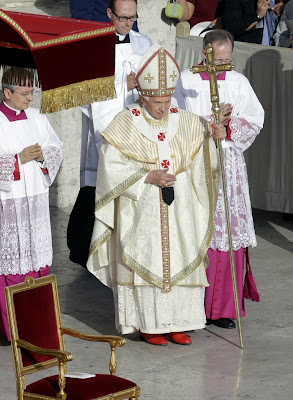The Return of the Papal Fanon
Oct 21, 2012 at 7:29 am
Perhaps many of us had thought that the Pope had about done with what he felt he could do in terms of restoring of certain traditional elements of papal liturgical ceremonial. Well, it turns out that wasn't quite the case. At this morning's canonizations in Rome, where notably Kateri Tekakwitha named first Native American saint (itself newsworthy in its own right), papal ceremonialists will note the return of the papal fanon.
Here are some photos:



So what is the fanon you might ask? Here is what the Catholic Encyclopedia says of it:





So what is the fanon you might ask? Here is what the Catholic Encyclopedia says of it:
Now some might yet ask, "what's the big deal? So a vestment was restored." However, the answer is that the use of vestments such as these are aspects of continuity and, by way of Msgr. Guido Marini himself, the papal ceremoniere, we know that this is purposefully so. Many years ago, Marini himself commented that "the vestments used ... aim to underline the continuity of today's liturgical celebration with that which characterized the life of the church in the past..." In that regard, this move is not just about restoring the fanon, it is also about restoring a connection with and yet further continuity with the Latin rite liturgical tradition.A shoulder-cape worn by the pope alone, consisting of two pieces of white silk ornamented with narrow woven stripes of red and gold; the pieces are nearly circular in shape but somewhat unequal in size and the smaller is laid on and fastened to the larger one... The front part of the fanon is ornamented with a smallcross embroidered in gold... The fanon is like an amice; it is, however, put on not under but above the alb. The pope wears it only when celebrating a solemn pontifical Mass, that is, only when all the pontifical vestments are used. The manner of putting on the fanon recalls the method of assuming the amice... After the deacon has vested the pope with the usual amice, alb, the cingulum and sub-cinctorium, and the pectoral cross, he draws on, by means of the opening, the fanon and then turns the half of the upper piece towards the back over the pope's head. He now vests the pope with the stole, tunicle, dalmatic, and chasuble, then turns down that part of the fanon which had been placed over the head of the pope, draws the front half of the upper piece above the tunicle, dalmatic, and chasuble, and finally arranges the whole upper piece of the fanon so that it covers the shoulders of the pope like a collar. The fanon is mentioned in the oldest known Roman Ordinal, consequently its use in the eighth century can be proved. It was then called anabolagium (anagolagium), yet it was not at that period a vestment reserved for the use of the pope. This limitation of its use did not appear until the other ecclesiastics at Rome began to put the vestment on under the alb instead of over it, that is, when it became customary among the clergy to use the fanon as an ordinary amice. This happened, apparently in imitation of the usage outside of Rome, between the tenth and twelfth centuries; however, the exact date cannot be given. But it is certain that as early as the end of the twelfth century the fanon was worn solely by the pope, as is evident from the express statement of Innocent III (1198-1216). The vestment was then called an orale; the name of fanon, from the late Latin fano, derived from pannus, (penos), cloth, woven fabric, was not used until a subsequent age. Even as early as the eighth century the pope wore the fanon only at solemn high Mass...
Feed:
Canonical link: The Return of the Papal Fanon
